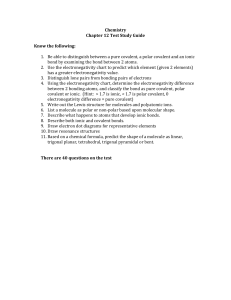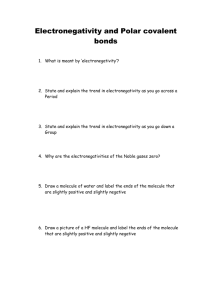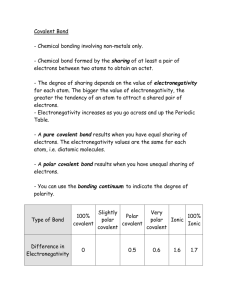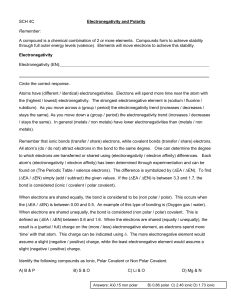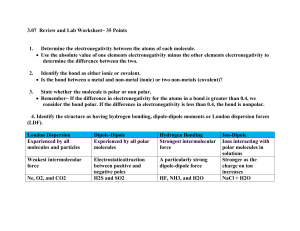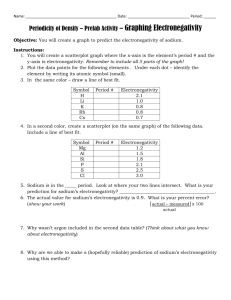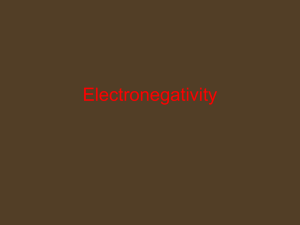Chemical Bonding Revision 1 Solutions 1) A compound is a
advertisement
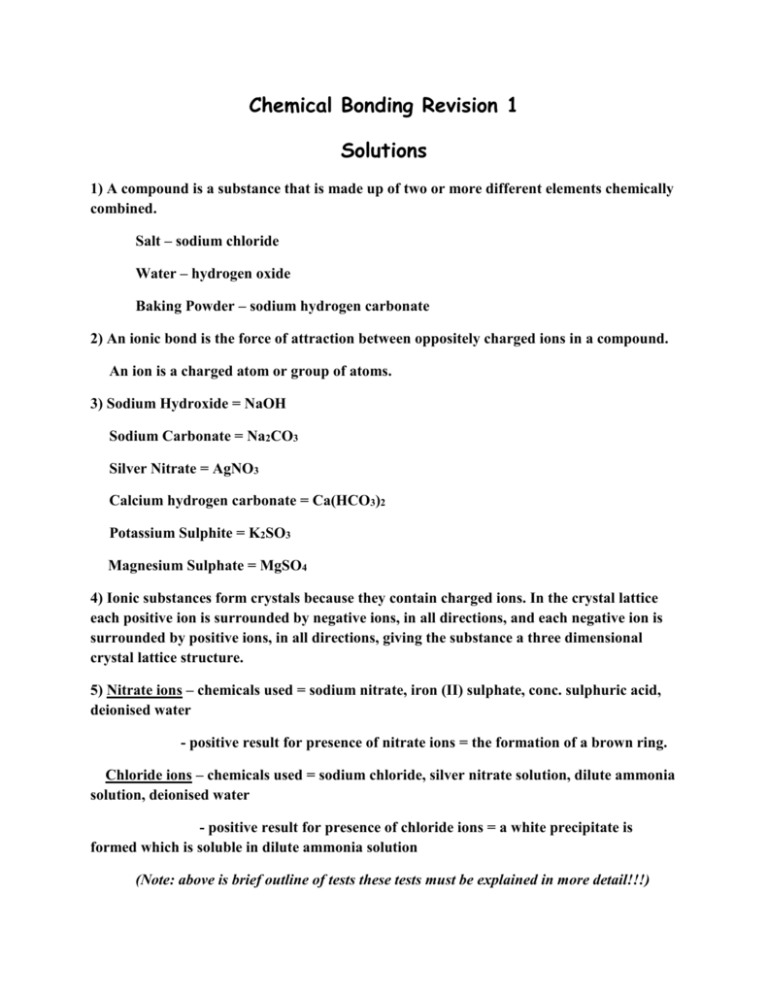
Chemical Bonding Revision 1 Solutions 1) A compound is a substance that is made up of two or more different elements chemically combined. Salt – sodium chloride Water – hydrogen oxide Baking Powder – sodium hydrogen carbonate 2) An ionic bond is the force of attraction between oppositely charged ions in a compound. An ion is a charged atom or group of atoms. 3) Sodium Hydroxide = NaOH Sodium Carbonate = Na2CO3 Silver Nitrate = AgNO3 Calcium hydrogen carbonate = Ca(HCO3)2 Potassium Sulphite = K2SO3 Magnesium Sulphate = MgSO4 4) Ionic substances form crystals because they contain charged ions. In the crystal lattice each positive ion is surrounded by negative ions, in all directions, and each negative ion is surrounded by positive ions, in all directions, giving the substance a three dimensional crystal lattice structure. 5) Nitrate ions – chemicals used = sodium nitrate, iron (II) sulphate, conc. sulphuric acid, deionised water - positive result for presence of nitrate ions = the formation of a brown ring. Chloride ions – chemicals used = sodium chloride, silver nitrate solution, dilute ammonia solution, deionised water - positive result for presence of chloride ions = a white precipitate is formed which is soluble in dilute ammonia solution (Note: above is brief outline of tests these tests must be explained in more detail!!!) 6) Electronegativity is the relative attraction that an atom in a molecule has for the shared pair of electrons in a covalent bond. 7) i) Electronegativity increases across a period. ii) Electronegativity increases across a period because of: 1. Increasing effective nuclear charge – number of protons in nucleus is increasing as move from left to right across a period. As a result, the attraction between the nucleus and the outer electrons is increasing. Therefore the electrons involved in bonding are being more strongly attracted to the nucleus i.e. electronegativity increases 2.Decreasing atomic radius – atomic radius decreases from left to right so outer electrons drawn closer to nucleus. Due to increased attraction between electron in outermost shell and nucleus the electronegativity values increase. 8) Al2O3 Electronegativity Al = 1.61 Electronegativity O = 3.44 Difference = 1.83 therefore ionic bonding H2 O Electronegativity H = 2.2 Electronegativity O = 3.44 Difference = 1.24 therefore polar covalent Hδ+ - OδHδ+ OF2 Electronegativity F = 3.98 Electronegativity O = 3.44 Difference = 0.54 therefore polar covalent Fδ-- Oδ+ Fδ- 9) KF – ionic compound NO – polar covalent Use electronegativity values to determine Br2 – Non-polar (pure covalent) polarity IBr – slightly polar CaO – ionic compound i) Dissolve in water = KF & CaO ii) Conduct electricity when dissolved = KF & CaO iii) Dissolve in cyclohexane = NO, Br2, IBr 10) 5525Mn3+ 55-25 = 30 neutrons 25 – 3 (lost 3 electrons) = 22 electrons 11) A covalent bond is the chemical bond formed by sharing a pair of electrons A molecule is a group of atoms joined together. It is the smallest particle of an element or compound that can exist independently. 12) When two pairs of electrons are shared (between two atoms), we say that a double bond is formed. 13) KF – Ionic bonding (use electronegativity values) 14) i) Beryllium and Oxygen – BeO ii) Hydrogen and Arsenic – AsH3 14) iii) Carbon and chlorine – CCl4 15) Sulphate and Sulphite ions – chemicals used = sodium sulphate, sodium sulphite, barium chloride, dilute HCl, deionised water Positive result for the presence of sulphate and sulphite ions = upon addition of barium chloride a white precipitate is formed in both Distinguishing test = upon addition of HCl precipitate in sulphite dissolves and in sulphate remains (Note: above is brief outline of test this test must be explained in more detail!!!) 16) Sodium Chloride is an ionic substance and will conduct electricity when either dissolved in water or when molten (i.e. melted). 17) Electronegativity is the relative attraction that an atom in a molecule has for the shared pair of electrons in a covalent bond. Electronegativity decreases down a group because of: 1. Increasing atomic radius: - atomic radius increases – outermost electrons are moving further away from attractive force of nucleus. Therefore smaller attraction between the nucleus and the shared pair of electrons 2. Screening Effect: - inner electrons screen outer electrons from the positively charged nucleus – since it is outermost electrons involved in bonding, the attraction of the nucleus for these electrons decreases going down the group i.e. electronegativity decreases. 18) GeS2 Electronegativity Ge = 2.01 Electronegativity S = 2.58 Difference = 0.57 therefore polar covalent Sδ- - Geδ+ - Sδ- CaS Electronegativity Ca = 1.00 Electronegativity S = 2.58 Difference = 1.58 therefore ionic bonding 18) PBr3 Electronegativity P = 2.19 Electronegativity Br = 2.96 Difference = 0.77 therefore polar covalent Brδ-- Pδ+ - BrδBrδ19) NaBr – ionic compound HCl – polar covalent Use electronegativity values to determine F2 – non-polar (purely covalent) polarity MgS – ionic compound CaCl2 – ionic compound i) have high melting points – NaBr, MgS, CaCl2 ii) dissolve in water – NaBr, MgS, CaCl2 iii) do not conduct electricity – F2 (HCl – although this is a covalent substance it DOES conduct electricity) 20) 168O216-8 = 8 neutrons 8 + 2( 2- indicates 2 electrons were gained) = 10 electrons

